The consulting and professional services firm BRAINTRUST, a leader in the tourism sector, has issued a new industry analysis, in this case on travel spending by foreign tourists thanks to a new wave of its Tourism Barometer, where it makes its own forecasts.
In them, he states that this year the record number of international travelers would be beaten again, surpassing the 83 million of 2019, reaching 85 million in 2023, and what is more important, the 100,000 million euros in spending would be reached, attracting a type of foreign tourist with a greater purchasing power, standing at approximately 12% over the pre-pandemic level.
Fewer foreign tourists in 2022, even though they have spent more
BRAINTRUST delves into foreign travel spending, analyzing changes versus pre-COVID, given that 2022 can be considered the year of recovery.
In this context, the number of foreign tourists has reached 71 million, still below 2019 levels by 14.3%, mainly caused by the lack of some nationalities that have seen their restrictions on movement lifted later, such as Asian or American countries, and the lack of travelers from markets close to the conflict in Ukraine, travelers who are expected to return as early as 2023.
However, the data invite optimism, since the average expenditure per traveler grew by 10.5%, due in part to a slightly longer stay of 5.7%, which together with the rise in prices due to inflation, leads to a higher total expenditure in our country.
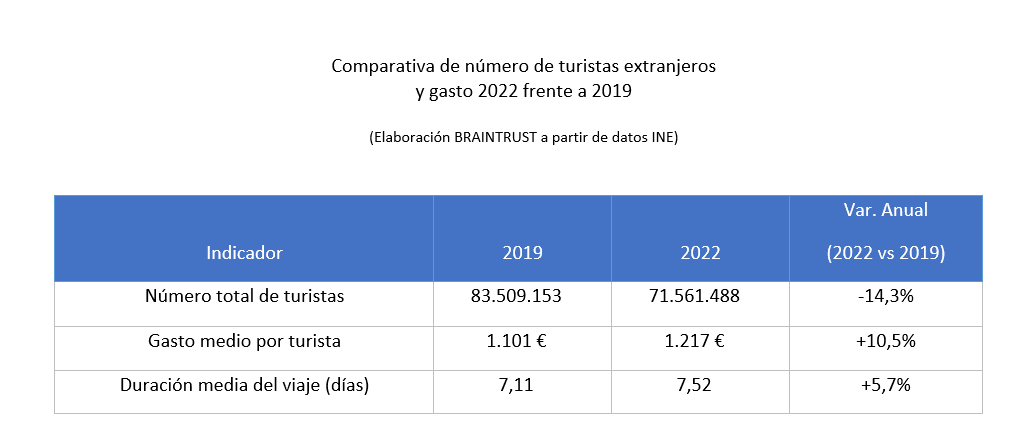
Lodging, the type of expenditure that increases the most
Analyzing the data separately, BRAINTRUST manifests the clear difference between the different expenditure items, highlighting the increase of the same in the accommodation category, with 13.1% more compared to the same period of 2019. On the other hand, other types of expenditure fell sharply, with package tours being the most affected, with a 19.5% drop, and transport suffering a 12.4% drop, while spending on meals and leisure activities remained the same, given the wide, rich, varied and experiential offer of our country, which is increasingly attracting foreign tourists.
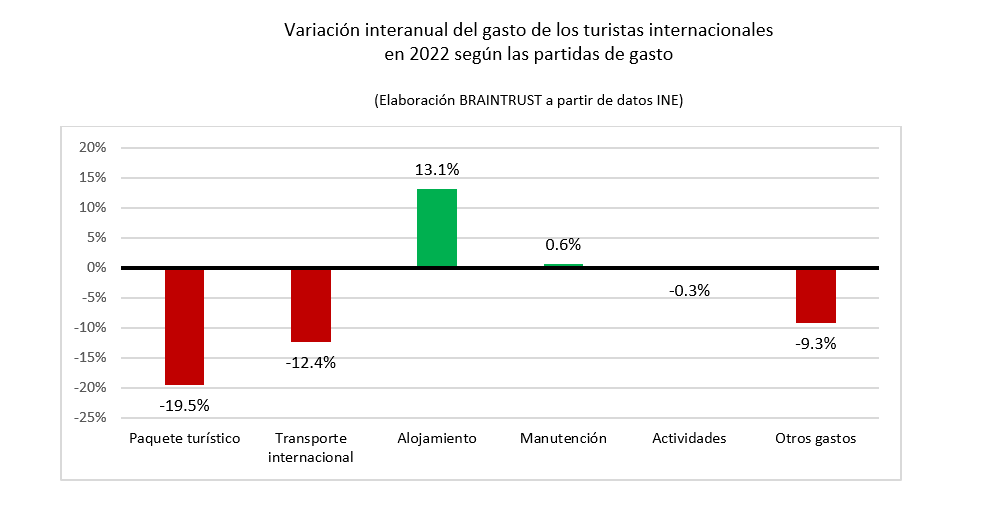
Hotel accommodation rises vs. non-hotel accommodation
The work done so far gives us a clue that we are going in the right direction, seducing a tourist with higher spending at the destination, as evidenced by the fact that they have lengthened the average stay, and also that they have chosen hotel accommodation to a greater extent compared to the extra-hotel accommodation of the pre-pandemic years.
This is highlighted by the data according to the consultant, who reflects that the first has grown to 68.6% coming from a percentage of 65.8%, which clearly comes to recognize the efforts of tourism organizations in Spain, as well as the strategies of the companies, pursuing the search for what has been called "a higher quality tourist".
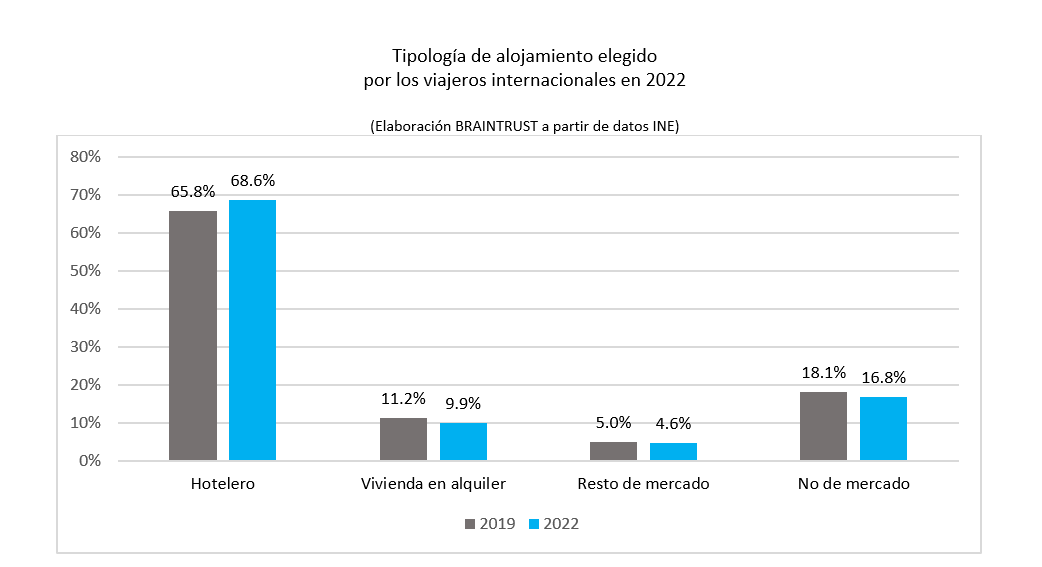
ForJosé Manuel Brell, Partner in charge of the Quantitative Studies and Models practice, and of the Tourism and Leisure Industry at BRAINTRUST: "The data invite optimism and reflect the good work of tourism managers at both the public and private levels, although this should not be an excuse to forget the necessary transformation of the industry and adapt it to the new times, to new travelers, and to new habits and behaviors.
This requires a constant analysis of data, evaluating the extent to which plans are being fulfilled not only in quantity but also in quality, adapting strategies in a timely manner so as not to die of success, laying the foundations for a new tourism of the future.
At BRAINTRUST we always say that a simple piece of data can hide behind it a deeper and more profound analysis that should be observed, and not throw the bells to the flight at the first time, but take them with business vision and contextualize them in an analytical model of value, which fully justifies the numbers".
A new record number of foreign tourists would be set in 2023, reaching 85 million, while total expenditure would be close to 100 billion euros.
With all these data in hand and with its new wave of the Tourism Barometer, BRAINTRUST predicts that, given the current situation and with no relevant potential risks in sight, 2023 could be another record year both in number of tourists, reaching 85 million, and in total expenditure, reaching 100,000 million, provided that no new black swans appear, and that the economy maintains its forecasts both from the point of view of growth and moderation of inflation in the main markets of origin of tourists to Spain.
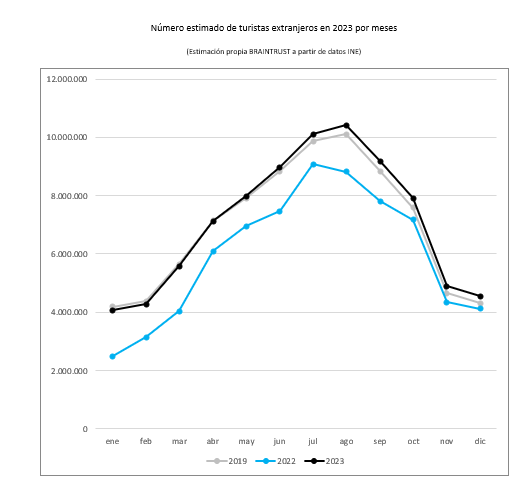
For Angel García Butragueño, Co-Director of the Tourism Barometer, and Director of Tourism at BRAINTRUST: "The real challenge is to continue the recovery while taking advantage of the opportunity to design a more sustainable tourism, with a greater positive impact on destinations and local societies. Despite the current economic situation, travel has become a priority for people, ahead of other previously priority expenditures, and the pandemic will see significant growth never before imagined".
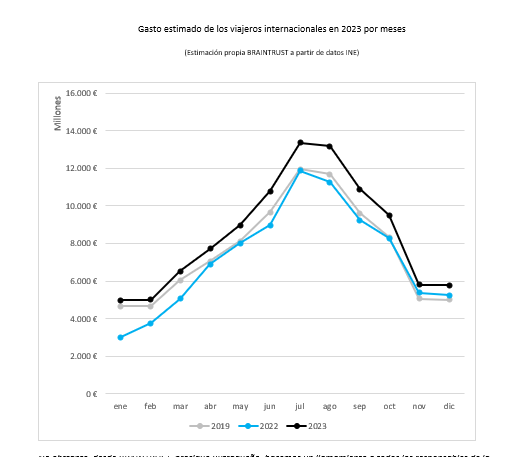
"However, from BRAINTRUST," continues Butragueño, "we call on all those responsible for the industry to materialize a change of vision of our model, so that we know how to take advantage of our tourism capital, while redesigning a prototype that is certainly outdated, based on quantity and not so much on quality.
To fall into euphoria and miss the opportunity of the reconversion would be fatal for our industry and for our country, for this we need leaders with a renewed and innovative vision to lead the sector not only in the short, but in the medium and long term, positioning tourism as one of the fundamental axes of our economy, not only at a national level, but also at a regional and local level.
It is time to lay the foundations for future decades, where travel is synonymous with respect for the environment, heritage, culture and customs, involving indigenous societies in their construction, transition and management".






